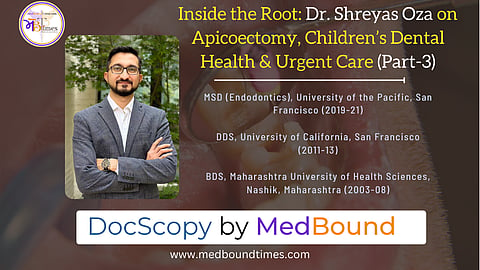Dr. Shreyas Oza: An apicoectomy, as the name suggests, involves the removal of the apex of a tooth's root. It is typically performed when a root canal has failed for various reasons. For example, if there is a separate instrument inside the canal, it can act as a blockage. If retreatment is attempted, the instrument might prevent access to the bacteria residing at the apex. Similarly, if retreatment appears successful but the tooth continues to get infected, anatomical challenges could be the cause.
For instance, if two adjacent canals have microscopic webbing between them, bacteria may persist in areas that instruments cannot reach. In such cases, an apicoectomy may be required to access and seal the affected area effectively. Sometimes there might be a cyst or an extraradicular infection that a conventional root canal won’t be able to address. Iatrogenic issues can also necessitate this procedure—for example, if a canal has a curve but a previous clinician inadvertently instrumented it straight, leaving an uncleanable portion. While it may be possible to correct such an error with the right skills and magnification, it is a highly challenging and not always successful process. In such cases, an apicoectomy might be the best option.
To summarize, an apicoectomy is indicated when there is a persistent infection due to anatomical factors, extra-radicular infection, blockages from separated instruments, or when retreatment would require destroying an existing crown or post. For instance, in a front tooth with a compromised top half, drilling out the restoration would further weaken the tooth, making an apicoectomy a more viable option.
Modern apicoectomy, also known as endodontic microsurgery, involves lifting the gum tissue, drilling a small hole into the bone to access the root end, removing 3mm of the root under magnification, and checking for cracks or fractures. Ultrasonic instruments are then used to clean the root interior, typically for 3-6mm, followed by sealing with bioceramic putty, MTA, or another suitable retrofilling material. This process prevents infection and endotoxins from re-entering the bone.
The difficulty of an apicoectomy varies—procedures on front teeth are generally simpler, while cases involving the palatal root of a maxillary molar can be more complex. Success rates depend on multiple factors, including the clinician’s surgical skill, whether prior retreatment was attempted, and the patient’s age and medical history among several other factors. If a root canal has been present for a long time and retreatment has already reduced bacterial load, the success rate of an apicoectomy is higher. On the other hand, simply cutting the root end without proper retreatment significantly reduces success.
Microsurgery improves outcomes—when ultrasonic retro-preparation and bioceramic sealing are used, success rates exceed 90%. However, if only the root end is cut without additional measures, the success rate drops below 50%. The use of magnification is crucial for detecting cracks and fractures. Age also plays a role—young patients tend to have better outcomes than older patients. While gender is not a major factor, multiple variables influence success, with technique and clinician expertise being critical components.


